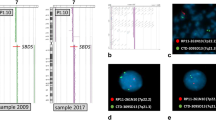Abstract
8p21.3 deletion was recently characterized in B cell lymphoma suggesting that TRAIL-R1 and TRAIL-R2 may be the target of the deletion and act as dosage-dependent tumor suppressor genes. As multiple myeloma is a plasma cell malignancy originating from B-lineage clonogenic cells, the idea was why do not evaluate this deletion in this pathology. Thus, interphase FISH studies with two mixtures of probes spanning the 8p21.3 region were retrospectively performed in 37 French multiple myeloma patients. Surprisingly, deletion in this region was found in 8 (21.6 %) patients. Interestingly, this deletion was usually associated with a 13q14 deletion. In two among them, the patients showed also translocation (4;14)(p16;q32) and one other harbor also a deletion of the P53 gene. These results indicate that deletion of TRAIL-R1 and TRAIL-R2 may be relevant to the loss of 8p21.3 and may play an important role the pathogenesis of MM. The association of this deletion with other well-known chromosomal aberrations in multiple myeloma suggests, as previously described, that these anomalies are not randomly distributed, but strongly interconnected.


Similar content being viewed by others
Explore related subjects
Discover the latest articles and news from researchers in related subjects, suggested using machine learning.References
Kyle RA, Rajkumar SV. Plasma cell disorders. In: Goldman L, Ausiello DA, editors. Cecil textbook of medicine. 22nd ed. Philadelphia, PA: W.B. Saunders; 2004. p. 1184–95.
Avet-Loiseau H, Attal M, Moreau P, Charbonnel C, Garban F, Hulin C, Leyvraz S, Michallet M, Yakoub-Agha I, Garderet L, Marit G, Michaux L, Voillat L, Renaud M, Grosbois B, Guillerm G, Benboubker L, Monconduit M, Thieblemont C, Casassus P, Caillot D, Stoppa AM, Sotto JJ, Wetterwald M, Dumonte C, Fuzibet JG, Azais I, Dorvaux V, Zandecki M, Bataille R, Minvielle S, Harousseau JL, Facon T, Mathiot C. Genetic abnormalities and survival in multiple myeloma: the experience of the Intergroupe Francophone du Myélome. Blood. 2007;109:3489–95.
Rubio-Moscardo F, David B, Mestre C, Siebert R, Balasas T, Benito A, Rosenwald A, Climent J, Martinez JI, Schilhabel M, Lorraine Karran E, Gesk S, Esteller M, deLeeuw R, Staudt LM, Fernandez-Luna JL, Pinkel D, Dyer MJS, Martinez-Climent JA. Characterization of 8p21.3 chromosomal deletions in B-cell lymphoma: TRAIL-R1 and TRAIL-R2 as candidate dosage-dependent tumor suppressor genes. Blood. 2006;106:3214–22.
Avet-Loiseau H, Facon T, Daviet A, Godon C, Rapp MJ, Harousseau JL, Grosbois B, Bataille R. 14q32 translocations and monosomy 13 observed in monoclonal gammopathy of undetermined significance delineate a multistep process for the oncogenesis of multiple myeloma. Cancer Res. 1999;59:4546–50.
Harris NL, Jaffe ES, Diebold J, Flandrin G, Muller-Hermelink HK, Vardiman J, Lister TA, Bloomfield CD. The World Health Organization classification of neoplasms of the hematopoietic and lymphoid tissues: report of the Clinical Advisory Committee meeting—Airlie House, Virginia, November, 1997. Hematol J. 2000;1:53–66.
McDonnell TJ, Korsmeyer SJ. Progression from lymphoid hyperplasia to high-grade malignant lymphoma in mice transgenic for the t(14; 18). Nature. 1991;349:254–6.
Lovec H, Grzeschiczek A, Kowalski MB, Moroy T. Cyclin D1/bcl-1 cooperates with myc genes in the generation of B-cell lymphoma in transgenic mice. EMBO J. 1994;13:3487–95.
Pitti RM, Marsters SA, Ruppert S, Donahue CJ, Moore A, Ashkenazi A. Induction of apoptosis by Apo-2 ligand, a new member of the tumor necrosis factor cytokine family. J Biol Chem. 1996;271:12687–90.
Wiley SR, Schooley K, Smolak PJ, Din WS, Huang CP, Nicholl JK, Sutherland GR, Smith TD, Rauch C, Smith CA. Identification and characterization of a new member of the TNF family that induces apoptosis. Immunity. 1995;3:673–82.
Takeda K, Smyth MJ, Cretney E, Hayakawa Y, Kayagaki N, Yagita H, Okumura K. Critical role for tumor necrosis factor-related apoptosis-inducing ligand in immune surveillance against tumor development. J Exp Med. 2002;195:161–9.
Takeda K, Smyth MJ, Cretney E, Hayakawa Y, Yamaguchi N, Yagita H, Okumura K. Involvement of tumor necrosis factor-related apoptosis-inducing ligand in NK cell-mediated and IFN-γ-dependent suppression of subcutaneous tumor growth. Cell Immunol. 2001;214:194–200.
Frank S, Kohler U, Schackert G, Schackert HK. Expression of TRAIL and its receptors in human brain tumors. Biochem Biophys Res Commun. 1999;257:454–9.
Daniels RA, Turley H, Kimberley FC, Liu XS, Mogkolsapaya J, Ch’en P, Xu XN, Jin B, Pezzella F, Gavin R, Screaton GR. Expression of TRAIL and TRAIL receptors in normal and malignant tissues. Cell Res. 2005;15:430–8.
Ryu B, Song J, Sohn T, Ralph H, Hruban RH, Scott E, Kern SE. Frequent germline deletion polymorphism of chromosomal region 8p12–p21 identified as a recurrent homozygous deletion in human tumors. Genomics. 2001;72:108–12.
Acknowledgments
We are grateful to all the team of the Hematology Department, University Hospital Hôtel Dieu, Nantes, France and special thanks to Nadège Gouy, Audrey Ruau, Amandine Gaudet, Marine Aliaga, Cyrille Pierre.
Conflict of interest
None.
Author information
Authors and Affiliations
Corresponding author
Rights and permissions
About this article
Cite this article
Gmidène, A., Saad, A. & Avet-Loiseau, H. 8p21.3 deletion suggesting a probable role of TRAIL-R1 and TRAIL-R2 as candidate tumor suppressor genes in the pathogenesis of multiple myeloma. Med Oncol 30, 489 (2013). https://doi.org/10.1007/s12032-013-0489-8
Received:
Accepted:
Published:
DOI: https://doi.org/10.1007/s12032-013-0489-8




